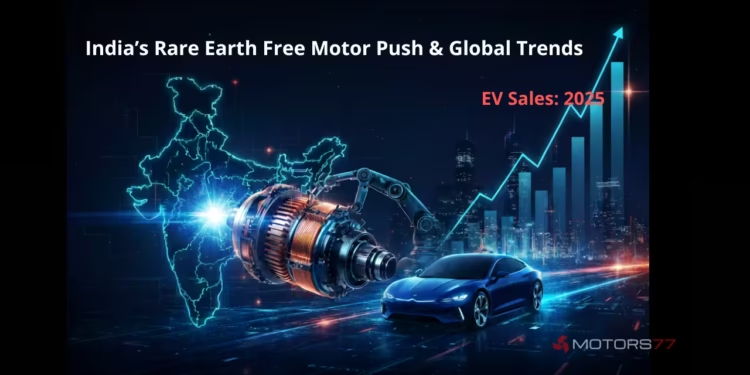Electric vehicles are no longer niche. In mid-2025, plugin vehicles (battery EVs + PHEVs) captured nearly 26% of global new auto registrations, a sharp jump from around 18% in 2024.
China accounts for over 60% of these sales, led by BYD and NIO. Europe follows with around 22% thanks to strict emission mandates, while the US holds roughly 12%, driven by IRA tax credits. This boom isn’t just about cheaper batteries it’s powered by smarter, more efficient motor technologies that make EVs faster, greener, and more affordable.
India’s EV Momentum
India is accelerating too. EV penetration is climbing, with government targets aiming for 30% share by 2030. Current adoption remains under 10% but is growing rapidly, led by two and three-wheelers that dominate urban mobility.
The Production Linked Incentive (PLI) scheme has pumped billions into local EV and component manufacturing. Motors are the next challenge, with nearly 90% of rare earths imported from China. Any disruption risks production delays, making alternatives critical for India’s self-reliance.
Top Motor Trends Driving 2025’s EV Boom
Axial Flux Motors – Compact Powerhouses
Axial flux motors stack magnetic fields in a pancake design, delivering up to 30% higher torque density in smaller, lighter packages. Globally, Mercedes and Ferrari are integrating them into high-performance EVs. In India, startups are adapting axial flux for electric three-wheelers and compact EVs, boosting payloads and range for last-mile delivery fleets.
Rare-Earth-Free Motors – Sustainable & Affordable
With China restricting rare-earth exports, rare-earth-free motors are emerging as the sustainable solution.
- Conifer Motors in the US is developing ferrite based axial flux motors, aiming for lower costs and up to 98% efficiency.
- Chara Technologies in Bengaluru already supplies synchronous reluctance motors without rare earths to more than 30 Indian OEMs.
- Sterling Gtake in Faridabad is testing magnet free motors with multiple Indian automakers.
Such designs could cut production costs by around ₹1 lakh per car and add 10–15 km of extra range per charge, making EVs more accessible for India’s price-sensitive buyers.
In-Wheel Motors – Smarter Traction
In-wheel motors embed propulsion directly into the wheels, allowing instant torque vectoring, stronger regenerative braking, and independent wheel control. Globally, these are enabling sub three second acceleration times in premium EVs. In India, Mahindra is exploring in-wheel solutions for rugged SUVs, giving superior traction on uneven roads and a range boost on highways.
India Tests Rare-Earth-Free EV Motors
The Ministry of Heavy Industries is supporting pilot projects to test rare-earth-free motor technology. The aim is to reduce import dependency and build domestic ferrite and reluctance motor production capacity within the next three years.
This initiative is a vital step in India’s self-reliance mission. For Tata, Mahindra, and Ola Electric, adopting these technologies could cut costs significantly and expand EV affordability across the middle-class market.
Wrapping Up: Torque Up for Tomorrow
Global EV sales hitting 26% in 2025 is no accident. It’s the result of motor innovations that make vehicles more efficient, durable, and affordable. For India, rare-earth-free designs and axial flux breakthroughs could be the tipping point for mass adoption.
Motors77 Take: India’s EV journey is not just about batteries. The motor is the beating heart and in 2025, that heart is being reinvented. The next big question is which Indian automaker will be the first to bring a rare-earth-free EV motor to the market.










